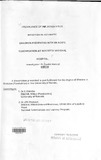| dc.contributor.author | Hemed, Twahir | |
| dc.date.accessioned | 2013-05-23T08:19:36Z | |
| dc.date.available | 2013-05-23T08:19:36Z | |
| dc.date.issued | 2001 | |
| dc.identifier.citation | Masters in Medicine in Paediatrics at the University of Nairobi, 2001. | en |
| dc.identifier.uri | http://erepository.uonbi.ac.ke:8080/xmlui/handle/123456789/24677 | |
| dc.description.abstract | There is limited local data on the prevalence of influenza viral infection in children and no
local data on the prevalence of influenza infection in asthmatic children. In temperate
countries where influenza infection is prevalent, there is clear evidence of association
between influenza and asthma exacerbation. Influenza virus infection is preventable in
t~h-risk individuals by vaccination. Determination of prevalence of influenza virus
infection in high-risk children such as asthmatics is important to eventually guide in local
policy on prevention of influenza infection.
The main purpose of this study was to determine the prevalence of influenza virus
infection and various strain-types in children with acute asthma exacerbation. It was
hoped that this information would provide the baseline data for research in determining
association between influenza virus infection and asthma exacerbation.
Methods
Over a 5-month period, 259 patients with acute asthma exacerbation were identified using
the WHO clinical criteria for asthma at the paediatric filter clinic of Kenyatta National
Hospital, Nairobi. Virological diagnosis of the influenza virus and strain-type was based on
immunofluorescence studies of nasopharyngeal aspirates obtained from the asthmatic
patients in acute exacerbation.
Results
The study subjects' median age was 2 years, (range 1 to 12 years), with 65.6% of the
children aged less than 2 years. Of the patients recruited, 151 were males and 108
females, giving a male to female ratio of 1.4: 1.
Thirty point-one percent of the study population was exposed to passive cigarette smoke
in their households, while 58.3% lived in one-bedroom houses. Twenty one point six
percent of the subjects had a family history of asthma, while charcoal was the main
source of cooking fuel, used in 54% of the homes. Mild exacerbation was the most
common type of exacerbation (87.6%). There were no children with severe exacerbation.
Wheezing was a common presenting symptom during an exacerbation (90.7%), and
15.4% of asthmatics had a high-grade fever (temperature ;::0: 38.50 C).
Forty-three children were found to have influenza virus in their nasopharyngeal aspirates,
giving a prevalence of 16.6%, and all influenza virus isolates in this group of asthmatics
were of strain-type B.
Conclusions and Recommendations
The prevalence of influenza viral infection was 16.6% (95% CI, 12 - 21%) among
asthmatic children with acute exacerbation presenting at Kenyatta National Hospital and
all influenza virus isolates were of strain-type B.
We recommend that an ongoing local surveillance for. and strain typing of influenza virus
infection be continued especially among high-risk groups such as asthmatic children as
this would determine the local influenza infection pattern. We also recommend that further
research be done to evaluate association between influenza virus infection and asthma
exacerbation. | en |
| dc.language.iso | en | en |
| dc.publisher | University of Nairobi | en |
| dc.title | Prevalence Of Influenza Virus Infection In Asthmatic Children Presenting With An Acute Exacerbation At Kenyatta National Hospital | en |
| dc.type | Thesis | en |
| dc.description.department | a
Department of Psychiatry, University of Nairobi, ; bDepartment of Mental Health, School of Medicine,
Moi University, Eldoret, Kenya | |
| local.publisher | Faculty of Medicine | en |

